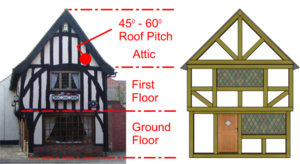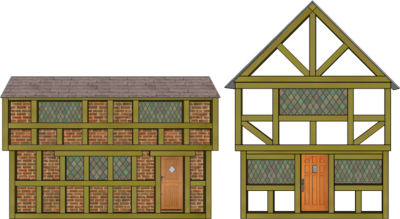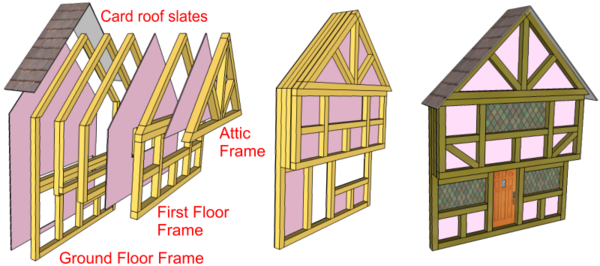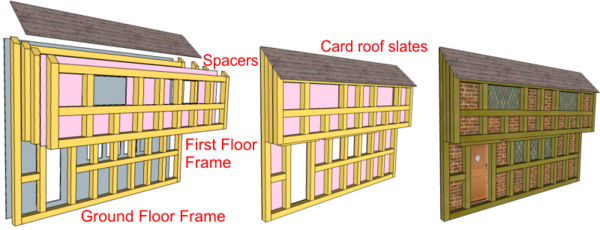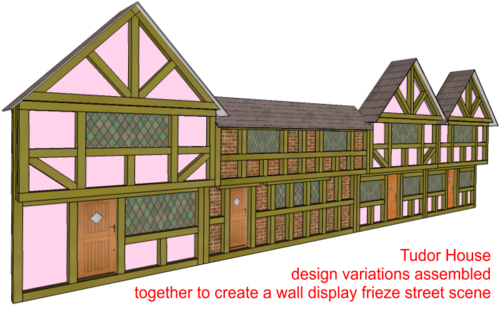Tudor Street Scene: Difference between revisions
From DT Online
(Created Article) |
m (Added Buyers Guide) |
||
| Line 21: | Line 21: | ||
* A sheet of '''[[Paper and Card|A4 Card]]]''' ''(medium or thick)'' provides a good starting point: use '''Portrait''' for '''Gable-ended''' houses and '''Landscape''' for others. | * A sheet of '''[[Paper and Card|A4 Card]]]''' ''(medium or thick)'' provides a good starting point: use '''Portrait''' for '''Gable-ended''' houses and '''Landscape''' for others. | ||
* The timber frames can be modelled at this scale by 8mm square '''[[Stripwood Technology Materials|Stripwood]]''' and glued in place using '''[[Glues and Pastes|PVA Glue]]''' | * The timber frames can be modelled at this scale by 8mm square '''[[Stripwood Technology Materials|Stripwood]]''' and glued in place using '''[[Glues and Pastes|PVA Glue]]''' | ||
* Infill panels can be painted, covered with brick patterned paper ''(either downloaded from the internet or purchased)'', or a pattern printed on using simple [https://en.wikipedia.org/wiki/Relief_printing sponge printing or potato printing] type techniques. ''(<span style="color: green">'''Note:''' paint, cover or print the A4 Card before any cutting out or other modelling.</span>)'' | * Infill panels can be painted, covered with brick patterned paper ''(either downloaded from the internet or purchased)'', or a pattern printed on using simple [https://en.wikipedia.org/wiki/Relief_printing sponge printing or potato printing] type techniques. A brick pattern printing block can also be made by gluing small rectangles of ‘foam board’ to a piece of wood using PVA glue. ''(<span style="color: green">'''Note:''' paint, cover or print the A4 Card before any cutting out or other modelling.</span>)'' | ||
* Roof panels can be made ot of thick card and finished in the same way as infill panels. Alternatively separate card tiles can be cut out and layered on - or the roof could be thatched! | * Roof panels can be made ot of thick card and finished in the same way as infill panels. Alternatively separate card tiles can be cut out and layered on - or the roof could be thatched! | ||
* Windows can be printed out from the internet or made from cellophane on to which a criss-cross lattice is drawn with a thin CD pen. | * Windows can be printed out from the internet or made from cellophane on to which a criss-cross lattice is drawn with a thin CD pen. | ||
| Line 44: | Line 44: | ||
The alternative, 'side-on' '''Tudor House''' designs and made similarly with the exception that only a separate '''First Floor''' card is needed. | The alternative, 'side-on' '''Tudor House''' designs and made similarly with the exception that only a separate '''First Floor''' card is needed. <span style="color: green">'''Note:''' the tops of each of the side spacers and the sides of the frames are cut at 45<sup>0</sup> to match the roof angle and it is this that determines distance down to the gutter</span> | ||
[[File:TudorHouseVersion2.png|600px|center]] | [[File:TudorHouseVersion2.png|600px|center]] | ||
| Line 52: | Line 52: | ||
{{Stripwood Materials Buyers Guide (1)}} | |||
[[Category:The Tudors]] | [[Category:The Tudors]] | ||
[[Category:Primary Technology]] | [[Category:Primary Technology]] | ||
Revision as of 12:55, 20 September 2017
Introduction
A complete Tudor Street Scene can be modelled as a series of Tudor House Box Models or using Stripwood Technology type constructions. But full 3D models would take up much time and space and so a semi-3D wall frieze can be a good way of displaying a local scene - (e.g. The Shambles, York).
Preparation
Visit or view photographs of Tudor Houses and note that many have a Ground Floor, First Floor and steeply angled roof which creates space for a room in the Attic. Some may also have a Second Floor. Even earlier than The Tudors there was some standardisation of lengths of timbers and the height of the Ground Floor (e.g. ‘In 1276 [in London] it was ordered that jetties, along with pentices and gutters, should be at least 9ft above the ground so as not to impede horsemen.’ ref. The Construction of Medieval and Tudor Houses in London, by Dr John Schofield).
Notice also that many present the steeply angled roof Gable to the street, but several other are side on. This observation suggests that at least two types of relief model will be needed to create a credible street scene.
Materials Available
- A sheet of A4 Card] (medium or thick) provides a good starting point: use Portrait for Gable-ended houses and Landscape for others.
- The timber frames can be modelled at this scale by 8mm square Stripwood and glued in place using PVA Glue
- Infill panels can be painted, covered with brick patterned paper (either downloaded from the internet or purchased), or a pattern printed on using simple sponge printing or potato printing type techniques. A brick pattern printing block can also be made by gluing small rectangles of ‘foam board’ to a piece of wood using PVA glue. (Note: paint, cover or print the A4 Card before any cutting out or other modelling.)
- Roof panels can be made ot of thick card and finished in the same way as infill panels. Alternatively separate card tiles can be cut out and layered on - or the roof could be thatched!
- Windows can be printed out from the internet or made from cellophane on to which a criss-cross lattice is drawn with a thin CD pen.
- Doors are made from thick card and most easily finished using a print-out from the internet and Adhesive Tape used to hinge them in position.
Note: Images from the internet can be saved by hovering over them and choosing Save Image As or similar from the right hand mouse button menu options. The saved image will then need to be loaded into software such as MS Paint, GIMP, Libre Office Draw and resized to suit the model.
House Designs
View photographs or visit actual Tudor Houses and draw a simplification of their designs across A4 Card - either Landscape or Portrait as determined by the house style. Start by drawing two lines across the card: one to represent the First Floor level and one for the Attic. For Gable-ended houses, the Attic level will be determined by first drawing the 450 roof angle from the top centre of the Portrait oriented card. For side-on houses, the Gutter line will be about 4 times the 8mm square Stripwood thickness plus the card thickness for the example shown (i.e. about 33mm in total).
Construction
The card for Gable-ended designs should be cut along the roof lines and the design for the First Floor and Attic reproduced on separate pieces of card. These will be spaced out and 'sandwiched' by layers of Stripwood to create the Attic projection and the overhanging Jetty as shown.
Windows and doorways should be cut out and the Card surfaces finished before assembling together with Stripwood spacers and frames. The lengths of Stripwood are most easily painted before being glued on to the card pieces.
The alternative, 'side-on' Tudor House designs and made similarly with the exception that only a separate First Floor card is needed. Note: the tops of each of the side spacers and the sides of the frames are cut at 450 to match the roof angle and it is this that determines distance down to the gutter
The two basic designs can be varied in terms of door and window positions for example, and a complete street scene created by assembling several together.
Notes:
- MDF Discs which are pre-drilled are most useful if available, otherwise this might be done as preparation before using with younger children - alternatively a Hand Drill Stand could be used (if neccessary, adults or older children can cut them out of strips of MDF or Ply using a Holesaw).
- Dowels 4mm, 5mm, and 6mm are useful sizes for axles.
- Florist Wire is easily bent into shape whereas stiff wire, such as Brass Brazing Rod, is more suitable for connecting rods.

